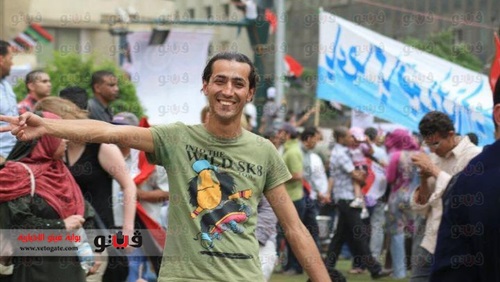Rami El-Sharkawy
Rami graduated from the Faculty of Computers and Information, but what he loved was graphic design, so he started working as a graphic designer. His sister Riham says: “He worked as a graphic designer. He was a true human being. A revolutionist by nature. He hated injustice and tyranny. He was one of the strongest people in their opposition to Mubarak’s regime. He participated since the 26th of January in the initiatives of the revolution that had taken place in Zagazig city. On the 27th of January, he traveled to Cairo to join the protesters at Tahrir Square.”
Rami participated in the Friday of Rage and continued on in the sit-in protest until Mubarak had stepped down, after which he went back to Zagazig. He used to go back to participate in the events in Cairo, like the incident of Mohamed Mahmoud and the House of Representatives in which he was killed. He was injured at the Battle of the Camels with a deep wound that required 8 stitches. He was also injured a month before he died at the Mohamed Mahmoud demonstration and later at the House of Representatives demonstration leading to his death 2 days later.
On the 20th of December during an escalation of violence during the clashes between military police and protesters, Rami was shot through the heart.
Doctor Hoda Anani, who knew Rami personally, said: “Before the revolution, Rami was an average guy. He only knew of the seated gatherings of coffee shops, however after he participated in the Friday of Rage his life completely changed to suddenly dreaming to achieve the best for his country even if it meant sacrificing his life. Over the course of his last few days, he was collecting signatures to set up a presidential field council and had dreams of seeing the military rule come to an end and taking back the rights of the martyrs.”
His sister says: “Among his most crucial demands after the revolution were, firstly: vengeance against the murderers of the revolutionists; secondly: continuing the demands of the revolution for which young people died for, which are ‘bread, freedom, social justice and human dignity;’ and that Egypt would become a democratic country as the martyrs and injured have long wished it to be.”
She described him as being kind-hearted, someone who would stay away from trouble, extremely loyal to his friends, known for his smile, and a beautiful soul that he shared with everyone. He was forgiving of everyone. He did his best in trying to console the families of the martyrs, to ease their pains and help them fight for the rights of their children. “He didn’t know that this would happen to them one day,” he sister said.




